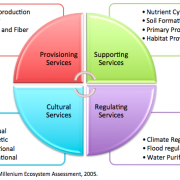Microchips Track Amazonian Trees to Support Sustainable Forestry Practices

A technician reads information, transmitted from a microchip attached to a tree, with his GPS device during a presentation of the Monitoring System Electronic Tracking and Forestry project in Nova Mutum in Mato Grosso state, August 28, 2010.
The identifiable roar of a chainsaw brings a gigantic Amazonian tree in Nova Mutum, Brazil to the forest floor.
This could be any other other day in the South American country where trees fall frequently each year in Brazil’s portion of the world’s largest forest. There is only one small detail that makes this one a little different: it is a “smart” tree; a microchip is attached to its base and contains data about its location, size and who cut it down. Each microchip tells the story of the individual tree’s life, from the point that it landed on the ground to the sawmill that processed and sold the wood, it has key information for buyers who want to know where it came from.
Though it is only a small pilot project, its leaders say the microchip system has the potential to be a big step forward in the battle to protect the Amazon. The chips allow land owners using sustainable forestry practices to distinguish their wood from that acquired through illegal logging that destroys swathes of the forest each year. Forestry engineer Paulo Borges from the organization Acao Verde, or Green action, which manages the project on a large farm, remarks:
People talk a lot these days about wood coming from sustainable forestry practices — this is a system that can prove it…
Brazil is under international pressure to reduce deforestation that destroys thousands of square miles of the Amazon each year, making the country one of the world’s biggest sources of greenhouse gasses. The project is part of a growing trend toward lumber certification that gives buyers a guarantee the wood was produced without damaging the forest it came from. Acao Verde says widespread use of chips in trees would help eliminate corruption that allows illegally harvested wood to be “cleaned up” through bogus certification papers, and aid in spurring Brazil’s sustainable forestry movement. Similar projects in Bolivia and Nigeria use technology such as bar codes readers or satellite tracking to help crack down on illegal logging and preserve delicate ecosystems. Acao Verde collected data on trees in 100 hectares (247 acres) of forest on the Caranda farm, which produces soy and corn but maintains native vegetation on a third of the land as required by law.

Forestry engineers attach chips contained in white plastic squares similar to office I.D. cards to each tree.
Landowners who adopt the system could cut down on time-consuming paperwork and reduce the need for inspections by environmental authorities, which for years have had tense relations with agribusiness in the region. Patrik Lunardi, 26, whose family allowed the project to be carried out on their farm see the chips as a transparent way to show their sustainable farming techniques:
People out there still think farmers like us are destroying the environment. It’s not true and we want to show that it’s not true.






































